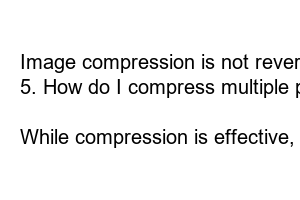사진 용량 줄이는 법
Title: How to Reduce Photo Size: A Comprehensive Guide
Introduction:
In this digital age, where stunning visuals shape our online experiences, it’s important to know how to optimize photos for the web. Large image sizes can slow down your website, resulting in longer loading times and frustrated visitors. Fear not! With a few simple steps, you can effectively reduce photo size without compromising on quality. Let’s dive in!
1. Understanding Image Compression:
Image compression is the process of decreasing the file size of an image without compromising its visual quality. Compressing photos helps to strike a balance between a smaller file size and maintaining image clarity. It’s a vital technique to optimize images for websites and ensure a smooth user experience.
2. Choosing the Right File Format:
Selecting the appropriate file format for your images is crucial. *JPEG* is the most commonly used format for photographs, providing a good balance between quality and file size reduction. On the other hand, *PNG* is ideal for images with transparent backgrounds, such as logos or graphics, but creates larger file sizes.
3. Utilizing Image Compression Tools:
Numerous *online tools and software* are available that make it easy to compress images without losing quality. Tools like *TinyPNG* and *JPEGmini* employ advanced algorithms to reduce photo sizes significantly. Simply upload your images, and these tools will take care of the rest, optimizing your visuals effortlessly.
4. Cutting Down Image Dimensions:
Rescale or *crop* your images to fit the intended display size. If your website’s width is 800 pixels, resizing your images to that width will reduce unnecessary data and trim down the file size. Additionally, cropping unnecessary elements can enhance the focus and visual appeal of your photos.
5. Adjusting Image Quality:
Most photo editing software and online tools offer the option to reduce the *image quality* to achieve smaller file sizes. Experiment with the quality setting, starting with a moderate reduction to find the perfect balance between size and clarity. Preview the image before saving to ensure it meets your requirements.
6. Minimizing Metadata:
Metadata within images contains auxiliary information such as the camera used, creation date, and author details. While useful, this data adds unnecessary weight to your image files. By *removing or minimizing metadata*, you can significantly reduce the file size without affecting the photo’s overall appearance.
7. Summary
In summary, reducing photo size is essential for optimizing your website’s performance and providing a top-notch user experience. By following these steps, including image compression, choosing the right file format, utilizing appropriate tools, adjusting dimensions, optimizing image quality, and minimizing metadata, you can effectively reduce photo size while maintaining visual integrity. With these techniques, you’ll ensure that your website loads quickly and your images shine brightly.
Frequently Asked Questions:
1. How much can image compression reduce photo size?
Image compression can reduce photo sizes by up to 70% without a noticeable loss in quality.
2. Will reducing photo size affect image resolution?
When done correctly, reducing photo size should not significantly impact image resolution.
3. Are online image compression tools safe to use?
Yes, reputable online tools prioritize data security and use advanced encryption to protect your images.
4. Can image compression be reversed?
Image compression is not reversible. Therefore, always keep a backup of your original, uncompressed images.
5. How do I compress multiple photos at once?
Batch compression tools like *Bulk Resize Photos* allow you to upload and process multiple images simultaneously.
6. Are there any limitations to image compression?
While compression is effective, excessively large images may still require resizing or using alternative techniques.

